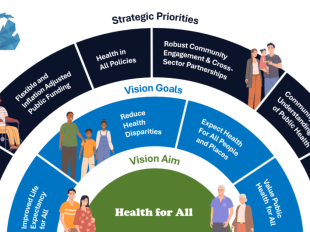Defining the forces and systems that shape health
The United States spends more on health care than its peer nations, yet its residents live unhealthier, shorter lives. To remedy this, public health and medical practitioners understand health care is not enough; they must address conditions where people are “born, grow, work and age.”
And there is more to the story.
Just as the social determinants of health influence how long and how well everyone lives, the structural determinants of health underly and shape those conditions. Structural determinants are made up of written and unwritten rules that govern society and reflect our values, policies, laws and institutional practices. Those with more power have more “say so” about the rules. And the rules determine who has power. Groups of people and places can be valued or devalued; treated with dignity, or disdained; and denied or afforded meaningful decision-making authority about how to create the conditions of daily living that are relevant to everyone’s health.
This is not new thinking. In 2010, The World Health Organization named how a wider set of forces and systems impact health. And scholars in this country describe and measure how our political, social and economic systems relate to health. But a common definition and understanding of the structural determinants does not yet fully inform practice.
A structural determinant approach could strengthen ongoing efforts that are focused on meeting the immediate needs of individuals, like the health care sector’s work to screen patients for health-related social needs, such as food security and safe housing.
Another example of this approach is found in Cornell University Associate Professor Jamila Michener’s research, which demonstrates how organized tenants are winning campaigns to assure housing conditions that are better for health. Listen to Michener’s recent In Solidarity podcast episode where she explains why power matters and how public health can support community organizers.
It’s possible to create a world where we value each other and see how our fates are connected. We can build healthy communities where everyone thrives. CHR&R will continue updating our data, evidence and tools to reflect structural determinants, including in 2025 when we will debut a model of health that reflects the structural determinants.
Our What Works for Health tool also includes strategies on participatory budgeting, public deliberations and labor unions that are aimed at structural determinants. Each strategy includes implementation examples and an analysis on its potential to decrease disparities.
Organizers are demanding the conditions that are necessary for health, building power and challenging the rules. Public health and health care practitioners can use their power to advance health and equity. Here are five things you can do:
- Learn about the intersections of power, oppression and health. Reflect on the power you have to make change;
- Reach out to community organizers and learn about their issues and campaigns;
- Collaborate with different types of organizations and groups. Strategize on how collective efforts can address urgent needs while also shifting power to change the rules that affect health;
- Provide organizers and policymakers data and evidence; and,
- Share information about how decisions are made and who makes them to help organizers and communities make change.
References
- Blumenthal, D., Gumas, E. D., Shah, A., Gunja, M. Z., & Williams II, R. D. (2024). Mirror, Mirror 2024: A Portrait of the Failing U.S. Health System. Commonwealthfund.org. https://doi.org/10.26099/ta0g-zp66
- CDC. (2024, January 17). Social determinants of health (SDOH). CDC. https://www.cdc.gov/about/priorities/why-is-addressing-sdoh-important.html
- Heller, J. C., Givens, M. L., Johnson, S. P., & Kindig, D. A. (2024). Keeping It Political and Powerful: Defining the Structural Determinants of Health. The Milbank Quarterly, 102(2). https://doi.org/10.1111/1468-0009.12695
- Michener, J. (2023). Racism, Power, And Health Equity: The Case of Tenant Organizing. Health Affairs, 42(10), 1318–1324. https://doi.org/10.1377/hlthaff.2023.00509



